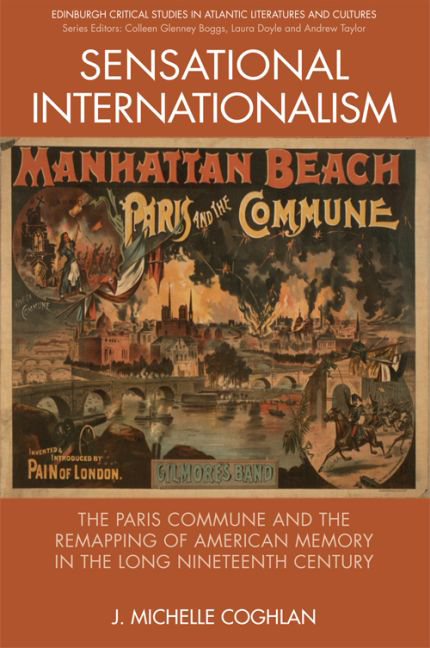 Sensational Internationalism
Sensational Internationalism Book contents
- Frontmatter
- Contents
- List of Illustrations
- Acknowledgments
- Series Editors’ Preface
- Introduction: Revolutionary Preoccupations: Or, Transatlantic Feeling in a Radical Sense
- 1 Framing the Pétroleuse: Postbellum Poetry and the Visual Culture of Gender Panic
- 2 Becoming Americans in Paris: The Commune as Frontier in Turn-of-the-Century Adventure Fiction
- 3 Radical Calendars: The Commune Rising in Postbellum Internationalism
- 4 Tasting Space: Sights of the Commune in Henry James's Paris
- 5 Restaging Horror: Insurgent Memories of the Commune in the 1930s
- Epilogue: Barricades Revisited – The Commune on Campus from FSM to SDS
- Notes
- Bibliography
- Index
3 - Radical Calendars: The Commune Rising in Postbellum Internationalism
- Frontmatter
- Contents
- List of Illustrations
- Acknowledgments
- Series Editors’ Preface
- Introduction: Revolutionary Preoccupations: Or, Transatlantic Feeling in a Radical Sense
- 1 Framing the Pétroleuse: Postbellum Poetry and the Visual Culture of Gender Panic
- 2 Becoming Americans in Paris: The Commune as Frontier in Turn-of-the-Century Adventure Fiction
- 3 Radical Calendars: The Commune Rising in Postbellum Internationalism
- 4 Tasting Space: Sights of the Commune in Henry James's Paris
- 5 Restaging Horror: Insurgent Memories of the Commune in the 1930s
- Epilogue: Barricades Revisited – The Commune on Campus from FSM to SDS
- Notes
- Bibliography
- Index
Summary
You need not be surprised, my friends, if you hear very soon that, I too, have been condemned to death for the cause. I will carry the red flag of the Commune and plant it everywhere in New England.
Lucy Parsons (1886)
On June 24, 1891, over 10,000 Coney Island “pleasure-seekers” attended the debut of a lavish pyrotechnic spectacle, “Paris, from Empire to Commune,” on Manhattan Beach. Billed in local newspaper advertisements as “a grand, living, moving tableau of history,” James Pain's newest pyrodrama offered its audience an immersive sensory experience that merged the outsized visual technology – and modes of seeing – of the panorama with the innovations of late nineteenth-century pyrotechnics while also tapping into the ongoing popularity of historically inflected melodramas. Claiming to exceed Pain's previous historical pyrotechnic shows in scale, interest, and ingenuity, “Paris, from Empire to Commune” involved not only a diverse display of fireworks, reputedly costing over $1,000 an evening, but also a live performance of colossal dimensions: a cast of over 300 costumed actors, acrobats, and circus performers, a 400 foot-wide stage, scenery of immense proportions that recreated Paris's monuments and streets in intricate detail, and a 120 foot-wide waterway situated between stage and crowd that represented the Seine and “afforded still greater opportunities for magnificent [pyrotechnic] effects.” This spectacular visual performance was accompanied – and, indeed, sensationally illustrated by – a no-less thrilling sonic experience, with dialogue and theatrical tableaux filled out by music from Gilmore's military band and the incessant whooshing and crashing of the hundreds of fireworks dancing across the sky above Manhattan Beach's newly opened 15,000-seat amphitheater. As the Rocky Mountain News later put it, “the crash of falling walls, the roar of explosions, the thunder of artillery and the blaze of the flames combined to form an impressive panorama.”
“Paris, from Empire to Commune” remained the hit of the season, with The Sun describing it as a “remarkably strong magnet” for Coney Island visitors and the Brooklyn Daily Eagle reporting that the nightly pyro-spectacular was continuing to draw crowds of “not fewer, at the lowest estimate, than eight thousand people” two months after it opened.
- Type
- Chapter
- Information
- Sensational InternationalismThe Paris Commune and the Remapping of American Memory in the Long Nineteenth Century, pp. 79 - 104Publisher: Edinburgh University PressPrint publication year: 2016


